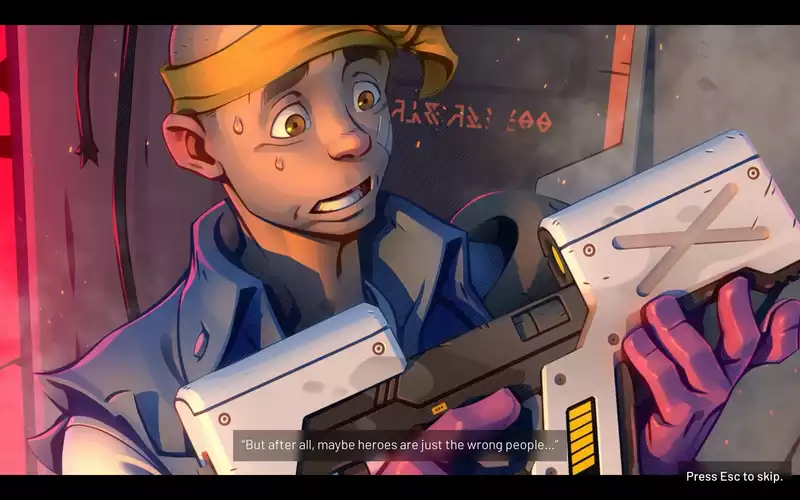A lot is happening in the partially abandoned space terminal of Endless Dungeon. Dubbed "The Station," the game ambitiously blends arcade-inspired run-and-gun, strategic tower defense, and rogue-lite dungeon crawler elements into its setting. It's a challenge to make the game cohesive and balanced. But developer Amplitude has accomplished most of it. The endless dungeon story setting is simple but effective. A group of outcasts are found stranded on a station. It once belonged to a mysterious group called the Endless. Today, only four monstrous tribes ravage the station's decks. Your job is to help a band of interstellar refugees escape from their prison, pushing through each floor and descending through the multiple zones of the generated dungeon to the station's interior. It's a fascinating core game loop that repeats itself, but in reality it's all about opening doors. More on that later. Endless Dungeons falls somewhere between the cyberpunk tradition and the handsome style of Hades. It's a fun, clean game that combines dramatically lit isometric interiors with cutscenes drawn in sharp comic form. The palette contrasts vibrant colors with brooding shadows, and although it doesn't stick to realism, Amplitude's work is so vividly detailed that the station feels like a realistic and cohesive place. Fortunately, it's also easy on the ears, thanks to a lush soundscape and a score that brings tension and momentum. But what about those doors? Well, each playthrough begins in a single room surrounded by exits. Open any of the bulkheads, and you'll find yourself in yet another hallway or room. There is no obvious, linear route to the exit you eventually seek, either to the next stage or down to the floor below. Likewise, it is usually next to impossible to know what lies beyond which door you have breached.
There may be an enemy spawn point, a research console to upgrade your defensive technology, or a gorgeous diorama scene littered with collectibles. And so you make your way through the station's labyrinthine interior, unleashing flashy firepower from multiple directions when danger looms. You also need to guide a spider robot of modest size, loaded with crystals that have the ability to open locked doors that cannot be entered by a squad alone. The crystal bot will wait at a specific point until you are ready to call it out and expect it to guide you safely to your next destination. Periodically, waves of enemies will spread into every open room in a particular zone and swarm your squad of crystal bots and up to three combatants. If only one or two spawn points are open, it is not too difficult to move your squad mates back and forth as you please for defense. However, as more rooms and spawn points are added, the wave becomes quite an ordeal. Fortunately, almost every open area has socket points pocked into the floor, each of which can be equipped with a variety of turrets. So you can spread out over increasingly large areas, filling them with strategically placed turrets to protect waiting bots or to rain hell down on spawn points as you explore the far reaches of the map.
As you walk through each door, you'll get three resources for pocket change: science, industry, and food. The first resource can be used to develop new turret technology using the research consoles scattered throughout the station. Industry allows the installation of valuable turrets and generators, and rewards are increased as they pass through each door. Food, on the other hand, upgrades the team's health and performance. Turrets are likewise essential to the defense of the placed generators. After all, when you are not fighting off long waves of monster hell, you are exploring, opening each procedurally generated stage, placing defenses, and deciding when to escort your bot accomplices to the next required point. The first few hours are deeply rewarding with ups and downs between each state. The shooting action is tight and energetic, and the twin-stick pad input works particularly well. Various weapon pickups, modifications, and new turrets can be used to exploit monster weaknesses, but skillful movement and carefully applied firepower are often enough.
With each level comes more rooms and spawning points, increasing difficulty, challenge complexity, and strategic promise, and for a while, the game is powerfully captivating. However, while the "endless dungeon" remains interesting throughout, it is all too familiar to repeatedly tumble through the core loop. There is not enough variety in characters and weapons, and finding bottlenecks to get through waves of enemies often leads to increasingly repetitive solutions. Overall, though, the game is impressive and engrossing. Particularly impressive is the level design, which, despite being procedurally generated, almost always feels human. Switching to online co-op multiplayer with friends or strangers makes Amplitude's creations feel less repetitive and considerably more dynamic. However, it might have been better to incorporate a bit more of Run & Gun's arcade roots. By employing short, punchy stages, the game keeps players away from the grind. Nevertheless, there is plenty of reason to return repeatedly to the "endless dungeon" escape quests. Not only because it is nearly impossible to break through the first few dozen times. In this charming bar, you can spend in-game currency to upgrade your weapons and other items. There is also another starting point available, so you don't have to go back to the beginning every time.
But you might want to. Because there are plenty of collectibles and upgrades, and a cast of characters there, there are plenty of reasons to revisit the endless dungeon over and over again.
.

Comments